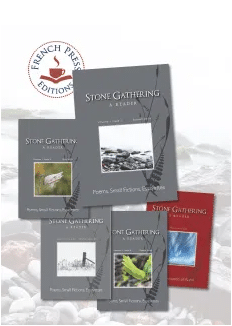
Get the Complete Set of Stone Gathering Volume 1, Issues 1-5 Here
Subscribe now to receive every issue of Stone Gathering, Volume 2
Welcome to Sunday Morning Lyricality, featuring a weekly song or poem by a Minnesota writer, followed by a prompt to help you write your own poem.
Most of us have reread a beloved book, watched a great movie again, or played a favorite song, one we’ve heard so often we can sing along. Professor Elizabeth Margulis, author of the recent On Repeat: How Music Plays the Mind explains in an interview with Mic, that when we revisit a familiar composition, we might experience a sense of “shared subjectivity.” Familiarity can cause the boundaries between our thoughts and the artists’ creation to blur. Reading a poem again and again is like seeing the same familiar face morning after morning. Like a beloved person, a well loved poem becomes part of us. I first encountered today’s poem two years ago, when I reviewed Paige Riehl’s book, Suspension. I came across it again last August on The Writer’s Almanac. And recently, on the first anniversary of my godfather’s death, while flipping through my well-worn copy of Suspension, the poem, “Things That Cannot Die,” whispered of hope, so I read it again. And again. We might find comfort in a cup of chamomile tea, a press pot of dark roast coffee, a hug, or the reassurance of a loved one’s voice. These days, when we are all in need of an extra measure of solace, people are returning to poetry. Today I am pleased to share with you, my lovely reader-friends, this gem of a poem, which has come to feel like a part of me.
Tracy Rittmueller
Things That Cannot Die
Paige Riehl
A spoon in a cup of tea.
Letters in yellow envelopes,
the way a hand pushed lines
into the soft paper.
Morning laughter.
A white shirt draped
over her chair.
An open window. The air.
Call of one blackbird.
Silence of another.
November. Summer.
My love for you, I say.
My love for you infinity
times a million, my son says.
Sounds of piano notes
as they rest in treetops.
The road from here to there.
Grief, that floating, lost swan.
Writing Prompt based on “Things That Cannot Die” by Paige Riehl
We offer writing prompts based on featured poems for people who want to write something, who need a little help getting started. We don’t imply that you ought to write something. Many people enjoy reading or listening to poems without feeling compelled to write one. You might simply read this prompt as an exploration into what the featured poem is doing, and how its language works. This can deepen your acquaintance with poetry and lead to great pleasure in being a reader of poems.
How to Write a “List Poem”
“Things That Cannot Die” is a list poem. A list poem collects, inventories, or catalogues related things. Paige Riehl’s list poem reminds me of visiting a single room in a museum. A curator selected and arranged this collection, but the thing they share in common is not readily apparent until we refer back to the title.
To write your own list poem, imagine yourself in an especially meaningful place. Home, perhaps, or somewhere that feels just right. It might be where your life took off on a new adventure, or where you gained a transformative insight. Now, list what you can see, hear, smell, taste, and touch in that place. Add in a fragment of conversation that evokes deep emotion for you. Capture just a few spoken words, as well as the response. Now do a little bit of free-association. Read over your list and let your mind wander to any memories that your list stirs up, and write those memories down, too. Put your list away for a few days. Don’t skip this resting step. It’s good to give your subconscious mind time to ruminate.
Notice that hidden beneath the arrangement of images in “Things That Cannot Die,” are the bones of a narrative arc surrounding the theme of love. By beginning in the domestic comfort of “a spoon in a cup of tea,” and ending in the confusion of “that floating, lost” experience of grief, this poem replicates the arc of every love story. At its center, “My love for you,” is repeated in heartbeat rhythm, ba-dum, ba-dum.
When you take out your list again, focus on your conversation fragment, and look for a universal theme in it. The most common universal themes for stories include:
- love;
- mortality;
- the battle of good vs. evil;
- coming of age or the loss of innocence;
- corruption & the misuse of power;
- courage & survival;
- the destructive consequences of prejudice or false belief;
- and war or battle — nation against nation or clan against clan, family member against family member, or individual against society.
Pick one of the above themes to supply context or add meaning to your conversation fragment.
Now look at your list and try to arrange the items in an order that hints at a simplified story arc. Common movements in stories are:
- from rages to riches;
- from riches to rags;
- from love to loss;
- from loneliness to belonging.
Slip your conversation fragment into the poem about 2/3 or 3/4 of the way through, the position where a story’s turning point or climax is often found. You might also find someplace to tuck in the name of your theme, if you are able to find a way to state it naturally.
You might feel your poem is complete now, or you might revise by including some juxtaposition. Notice how Paige places the sound of a bird’s call next to silence, and November next to summer, inviting the reader to experience the tension of contrast:
Call of one blackbird.
Silence of another.
November. Summer.
Paige might have used the word “July”, but “Summer” is a better choice, because of its a near rhyme with November, and because it brings in another contrast–1 month juxtaposed with a whole season.
If your poem still feels like it’s missing something, read “Things That Do Not Die” aloud–very slowly. Do this twice. Your mouth and tongue and feet will understand even before your brain comprehends, how sound repetitions and rhythms make this poem work. Now, look at each individual line and see what you notice about sound repetitions and rhythms. The sound in this poem has internal sound logic that makes it work like a musical composition. Notice how the words sound in your poem. What might you rearrange or change in your poem to repeat vowel and consonant sounds and rhythm patterns?
*****
Paige Riehl is the author of Blood Ties, a poetry chapbook published by Finishing Line Press (2014). Her poetry has appeared in many publications such as Meridian, South Dakota Review, Nimrod International Journal, and Thought & Action. She is the Poetry Editor for Midway Journal and an English faculty member at Anoka-Ramsey Community College just north of the Twin Cities in Minnesota where she is the Chair of the Two Rivers Reading Series.
“Things That Cannot Die” from Suspension by Paige Riehl ©2018, published by Terrapin Books. Appears with the permission of the author. (Buy Now)
